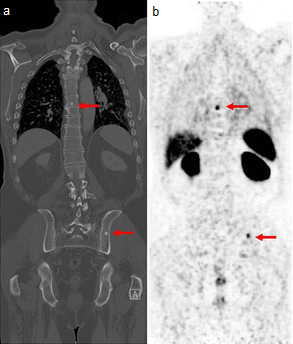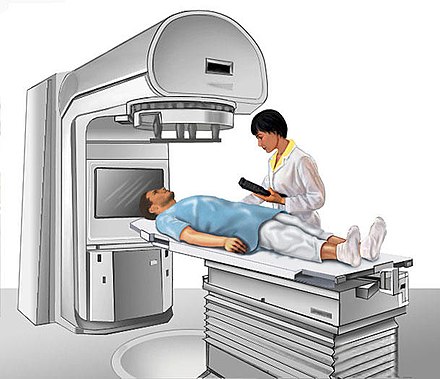Prostate Cancer
Prostate cancer is a type of male reproductive organ cancer characterised by the uncontrolled growth of cells in the prostate, a gland located below the bladder. It is typically screened through blood tests measuring prostate-specific antigen (PSA) levels, with high levels indicating an increased risk. A definitive diagnosis requires a biopsy, and the cancer is staged based on the Gleason score, PSA levels, and imaging results.

Signs and Symptoms
Early prostate cancer usually causes no symptoms. As it advances, it may lead to erectile dysfunction, blood in urine or semen, and trouble urinating, such as frequent urination and a weak urine stream. More than half of men over age 50 experience urination problems, typically due to benign causes like benign prostatic hyperplasia (BPH).
Advanced prostate cancer can metastasize to nearby lymph nodes and bones, particularly in the pelvis, hips, spine, ribs, head, and neck. This can cause fatigue, unexplained weight loss, and persistent back or bone pain. Metastases can also lead to bone fractures and spinal cord compression, causing leg weakness or paralysis.
Screening
Most prostate cancers are diagnosed through screening tests, including blood tests to measure PSA levels. Men with elevated PSA levels may undergo secondary screening tests that measure subtypes of PSA or other prostate-related proteins. While screening can reduce the risk of dying from prostate cancer, it can also lead to overdiagnosis and unnecessary treatments. Recommendations for screening vary, with most guidelines advising against screening men over 70 or those with a life expectancy of less than 10 years.
Diagnosis
Men suspected of having prostate cancer may undergo a digital rectal examination, where a doctor feels the prostate for irregularities. MRI is often recommended to evaluate potential tumours. A definitive diagnosis requires a biopsy, usually guided by transrectal ultrasonography or MRI. Biopsies are graded using the Gleason grading system, which assigns a score based on how much the tumour tissue differs from normal prostate tissue. Imaging techniques like MRI or PSMA scans are used to assess the extent of cancer spread.


Staging
Prostate cancer staging is based on the American Joint Committee on Cancer's (AJCC) TNM system, which assesses the tumour's size (T), spread to lymph nodes (N), and metastases (M). The AJCC combines TNM scores, Gleason grade, and PSA levels to categorise cancer into one of four stages. Lower stages indicate localised cancer, while higher stages indicate advanced disease with metastases.

Treatment
Localised Disease
Men with low-risk localised prostate cancer often opt for active surveillance, involving regular PSA tests, digital rectal exams, and MRIs. Treatment options include radiation therapy and prostatectomy, both of which have similar rates of cancer control but different side effects. Radiation therapy can cause erectile dysfunction and radiation proctitis, while prostatectomy can result in erectile dysfunction and urinary incontinence.


Metastatic Disease
For metastatic prostate cancer, androgen deprivation therapy (ADT) is the standard of care. ADT reduces androgen levels, which prostate cells require to grow. Various drugs are used, including GnRH agonists and antagonists. Despite initial success, metastatic prostate cancer eventually becomes castration-resistant, requiring chemotherapy and newer treatments like androgen receptor antagonists and PARP inhibitors.

Supportive Care
Supportive care focuses on alleviating symptoms caused by bone metastases, which are present in around 85% of metastatic prostate cancer cases. Pain management includes NSAIDs and radiation therapy. Bone-modifying agents like zoledronic acid and denosumab can reduce bone pain. Psychological interventions can aid in reducing anxiety and depression associated with advanced prostate cancer.
Self-assessment MCQs (single best answer)
What is the primary method used to screen for prostate cancer?
Which of the following symptoms is least likely to be associated with early-stage prostate cancer?
Which imaging technique is often recommended to evaluate potential prostate tumours before a biopsy?
What does the Gleason grading system measure?
What is androgen deprivation therapy (ADT) used to treat?
Which of the following is NOT a typical side effect of prostatectomy?
What percentage of men over age 50 experience urination problems, often due to benign causes?
Which system is used to stage prostate cancer based on tumour size, lymph node involvement, and metastases?
What is the main focus of supportive care in metastatic prostate cancer?
Which advanced treatment is used when metastatic prostate cancer becomes castration-resistant?
Dentaljuce
Dentaljuce provides Enhanced Continuing Professional Development (CPD) with GDC-approved Certificates for dental professionals worldwide.
Founded in 2009 by the award-winning Masters team from the School of Dentistry at the University of Birmingham, Dentaljuce has established itself as the leading platform for online CPD.
With over 100 high-quality online courses available for a single annual membership fee, Dentaljuce offers comprehensive e-learning designed for busy dental professionals.
The courses cover a complete range of topics, from clinical skills to patient communication, and are suitable for dentists, nurses, hygienists, therapists, students, and practice managers.
Dentaljuce features Dr. Aiden, a dentally trained AI-powered personal tutor available 24/7 to assist with queries and provide guidance through complex topics, enhancing the learning experience.
Check out our range of courses, or sign up now!


